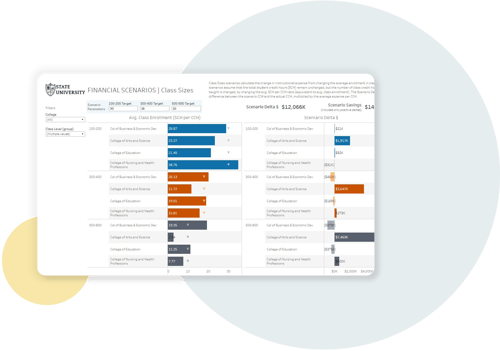Balancing a delicate - and necessary - financial scale
Successful academic portfolio evaluations require artful collaboration with department leaders where institutional financials may not be top of mind or well known. Regular review of program-level costs, shifts in student demand, and instructor utilization and course scheduling offer transparency into the total cost of instruction and decision points on the path toward financial sustainability for your institution.
Budget conscious, faculty friendly
Calming campus fears
The mere mention of academic portfolios can raise hackles on campus. Whether it be a misperception that the act is blindly cost-cutting, or a fear that important metrics aren’t accurately tracked to inform these choices, buy-in on campus can be difficult. The solution: centralized, standardized data, that puts your institution's nuances first.
Deeper visibility, better outcomes
A proper academic portfolio evaluation gives institutional leaders confident command of essential decisions with reliable data to assess difficult financial questions. Identify the cost of instruction, optimize course and instructor scheduling, and find ways to fund mission-centric, non-revenue-driving programs with other revenue-rich offerings. Academic portfolio evaluations, when done properly, unite a campus rather than pitting factions against one another.
Achieve your mission and sustainability
You need a centralized view of enrollment and instruction data to allow your institution to calculate true costs for teaching and non-teaching activities, optimize programmatic offerings, and make reliably informed recommendations and decisions that allow you to be intentional about the balance of mission-oriented academics in alignment with long-term financial sustainability targets.
What to ask about the true numbers driving your institutional experience
-
Which of your colleges and departments have increasing student credit hours?
- Are your departmental expenses aligned with demand and revenue?
- Which of your courses are being taught at positive contribution margins? Negative contribution margins?
- Which of your departments and courses are going to drive enrollment in future terms?
- Are the number of your course sections offered and their fill-rates commensurate with course demand?
- What are your opportunities to consolidate course sections to reduce faculty and facilities expenses?
- What percentage of your faculty’s time is spent on non-teaching activities?
- Where are your opportunities to balance teaching loads across academic departments?
- What percentage of your faculty are meeting or exceeding their teaching requirements?

Chart a financially sustainable path forward
Find out how HelioCampus Academic Performance Management can help you uncover insights related to contribution margins, instructor utilization, and course delivery and demand. Become your own consultant with ongoing access to reliable data that informs staffing and scheduling efficiencies or competitive course offerings in-line with current and future demand.
Improve academic programming efficiencies with deep data integrations
Academic Performance Management
Understand and manage the cost of instruction for your institution so you can better address budget deficits, identify efficiencies, and optimize faculty assignments and non-teaching activities.
-
Gain visibility into instructional costs and margins to inform academic planning
-
Identify trends in course demand or enrollment within academic departments
-
Maximize instructor capability across teaching and non-teaching activities
- Improve strategic planning and course offerings to support institutional sustainability

Academic Performance Management
Understand and manage the cost of instruction for your institution so you can better address budget deficits, identify efficiencies, and optimize faculty assignments and non-teaching activities.
-
Gain visibility into instructional costs and margins to inform academic planning
-
Identify trends in course demand or enrollment within academic departments
-
Maximize instructor capability across teaching and non-teaching activities
- Improve strategic planning and course offerings to support institutional sustainability



.png)